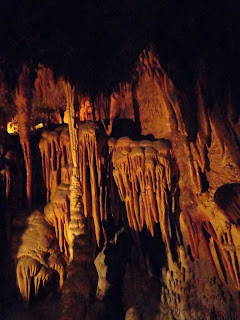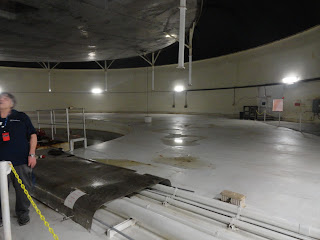Tourists. We played the role during our stay in Tucson. We took in three “museums”, in quotes because
none of the three quite fit the image of a big building with a collection of
stuff.
The Air and
Space museum has four or five huge buildings filled with old airplanes, but it
also has something like 80 acres of planes sitting in the desert sun where rust
threatens not.
There are a few
planes from the time after World War I, such as a biplane or a Taylorcraft.
Most of the
collection dates from World War II. We
caught on with a knowledgeable tour guide who told us about the history of many
of the WWII bombers and fighters stored in the buildings. There were a few helicopters and some
jet-powered aircraft in the buildings.
Huge behemoths rest on the tarmac
outside. It was a nice warm day with
only a slight breeze, so we spent some time taking a look.
The Desert Museum
should really be called a zoo. Various
animals inhabit cages and enclosures.
Something like a dozen different rattlesnakes laze behind glass. Three different ladies had non-poisonous
snakes wrapped around their arms, which visitors could stroke if they
wish. I didn’t wish. You can spend a
few hours wandering around the grounds outdoors.
You can take a
look at some stalactites or stalagmites.
Or some pig-like
animals called javelinas who roam the desert.
RV campers are advised not to leave garbage out because it will attract javelinas,
which can be destructive. They aren’t
really pigs. Joe pointed out any pig
would easily burrow under the fence and get out.
Raptors provided
the highlight of our visit. They put on
a show twice a day. They zoom down close
over the heads of their visitors to take meat from their handlers. Keep your camera down below your face, and
don’t hold small children on your shoulders.
They will be in the flight path and could be injured.
Perhaps the most
interesting place we visited was the Biosphere.
Like many folks, I had forgotten all about that experiment. It was an attempt to create an enclosed space
where humans could survive in an otherwise harsh environment, such as on the
moon or Mars.
It’s called Biosphere
2, Biosphere 1 being planet earth. It
consists of huge glass buildings with various types of environments enclosed,
such as a rain forest.
Or an ocean,
where they killed the coral by introducing too much CO2. An ongoing experiment is to revive the coral
by finding a species that can withstand higher levels of carbonic acid, the
product of water and CO2.
Of course, there
is a desert “scene”.
Underlying the indoor environment is a huge air-handler system.
Currently, it relies on fossil fuels to generate the electricity to operate pumps, fans, lights, etc. They are working on
developing solar power, which would be necessary on either the moon or Mars.
Finally, there
is the huge “lung” that makes it possible to keep an atmosphere enclosed
without deadly blowouts of glass panes as pressure varies from changes in
pressure from sunlight and the absence of solar rays, day and night, in other
words. As the air expands, the “ceiling”
rises. When the air cools, the “ceiling”
lowers, keeping the atmospheric pressure somewhat stable.
The experiment
started in the 1980’s, I think. It was
privately funded, land and materials mostly donated. Now, it is funded and run by University of
Arizona.
Originally,
eight people spent two years inside. A
second group of people began a term inside, but the experiment was halted,
partially due to problems the first eight developed as a result of the
isolation. In a way, it was the
forerunner of modern day survivor TV shows.
The experiment
continues, but without the human guinea pigs.
It will be interesting to see the results of trying to create viable
systems separated from Biosphere 1.























No comments:
Post a Comment